So you’ve booked a Norway winter getaway, but now you’re worried about what outdoor clothing you’ll need to stay warm. Worry no more, this guide has everything you need to know about which Norway clothing you need to pack to keep warm during your visit.
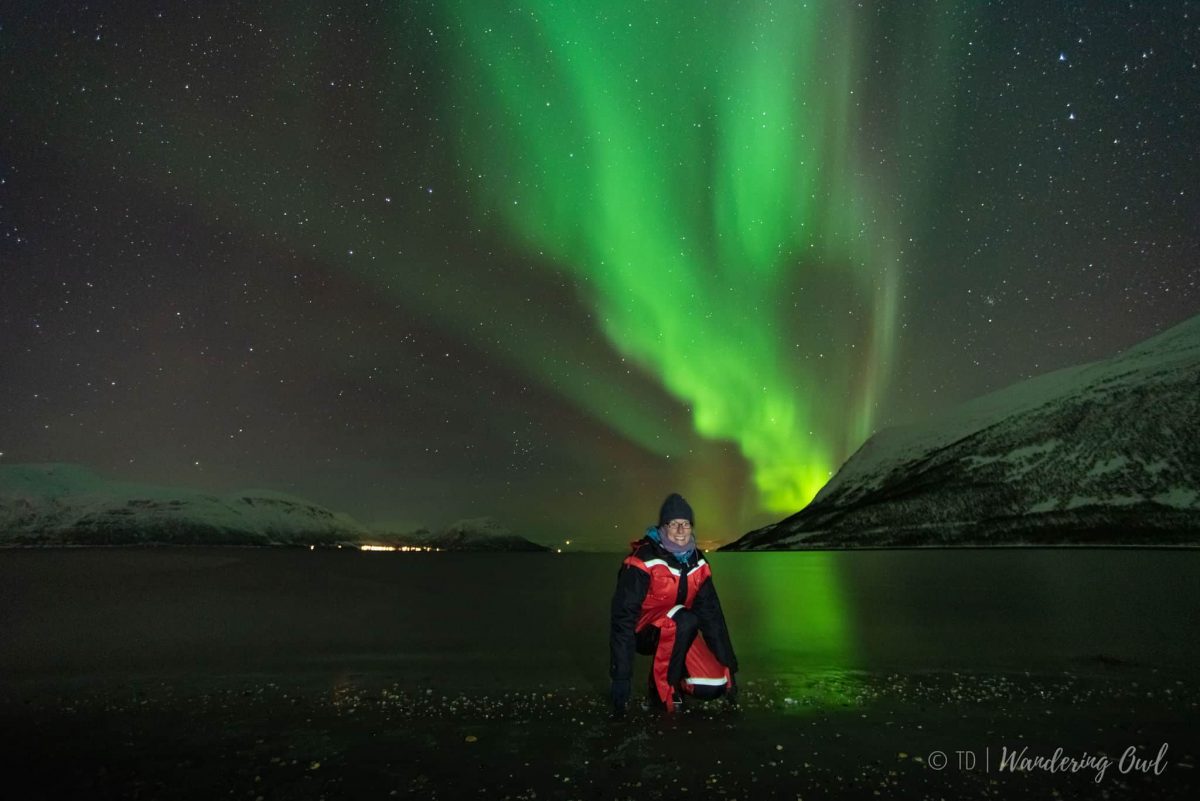
Norway winter holidays are popular as its one of the best places to go to see the northern lights. However, as temperatures can often be below zero degrees, packing the right winter clothes has numerous benefits. Staying warm will ensure that you enjoy your visit as there’s nothing worse than feeling bitterly cold.
This article may contain compensated links. Please read my disclaimer policy for more info.
Norway Winter Clothing at a Glance
The phrase:
“There’s no such thing as bad winter weather, just bad winter clothing”
and similar versions of it have been quoted by many sources. When you visit Norway dress appropriately for the weather conditions, and you’ll find the cold temperatures no problem.
Forget about trendy winter clothing and pack winter wear clothes that will actually keep you warm.
If you are short on time the table below gives a quick guide to winter clothing. However, if you want to learn more, the post that follows goes into detail on what to wear in Norway during winter.
- Men’s Winter clothing at a glance
- Women’s Winter clothing at a glance
- Extreme Winter clothing
- Kid’s Winter clothing
- Northern Lights Winter clothing
Click here for more in-depth detail on how to keep yourself warm during your stay in Norway.
Quick Glance at Men’s Winter Clothing.
- QUALITY MIDWEIGHT BASELAYER: 100% Merino Wool is…
- QUALITY MIDWEIGHT BASELAYER: 100% Merino Wool is…
- European sizing – please refer to size chart for…
- FUNCTIONALITY: Center front zipper with snap…
- Warmth and Insulation: OZERO winter gloves with…
Quick glance at best Women’s winter clothing.
- QUALITY MIDWEIGHT BASELAYER: 100% Merino Wool is…
- QUALITY MIDWEIGHT BASELAYER: 100% Merino Wool is…
- Fearless by WoolX – comfort at its finest
- Standard fitTwo way, VISLON center front zip;…
- 【WARM GLOVES】 These winter gloves are made of…
Extreme Winter clothing
- 『Lightweight & Warm Keeping』: High skin friendly…
- 【Ultra Soft & Warm】LAPASA thermal underwear…
- Removable, helmet compatible hoodUnderarm vents;…
- Pair of gloves each featuring channel quilting and…
- Standard fit
Kids Winter Clothing
- STAY-PUT DESIGN: Oversized jackets? Check. Bulky…
- STAY-PUT DESIGN: Oversized jackets? Check. Bulky…
- 100% Polyester
- Machine wash
- WATERPROOF, WARM AND SNOW-PROOF: The children’s…
Northern Lights Clothing
- 【HEATED AREAS】Heated Vest has Three color…
- QUALITY MERINO WOOL GLOVE LINERS: 85% Merino Wool….
- 🔥TAILGATE BUNDLE – Stock up and save with our…
Layers winter clothing
It’s no secret that wearing layers is the best way to insulate your body. Norwegian winter temperatures vary dramatically depending upon which region you are visiting.
In cities such as Oslo, you’re not going to need the same number of layers as on a northern lights excursion. For that reason understanding the concept of layered clothing will help.
When you wear layers, the warm air released by your body gets trapped between the clothes and acts as an insulator. When you remove a layer, you instantly cool down as the air is released.
Wearing multiple garments is excellent as you can add and remove them throughout the day according to what activities you are doing. Always start with a base layer as its the first layer of protection against the cold.
Base Layers for Norway Clothing
The base layer is the first layer that goes next to your skin. It’s a vital layer not only to stay warm but to control the moisture that your body expires.
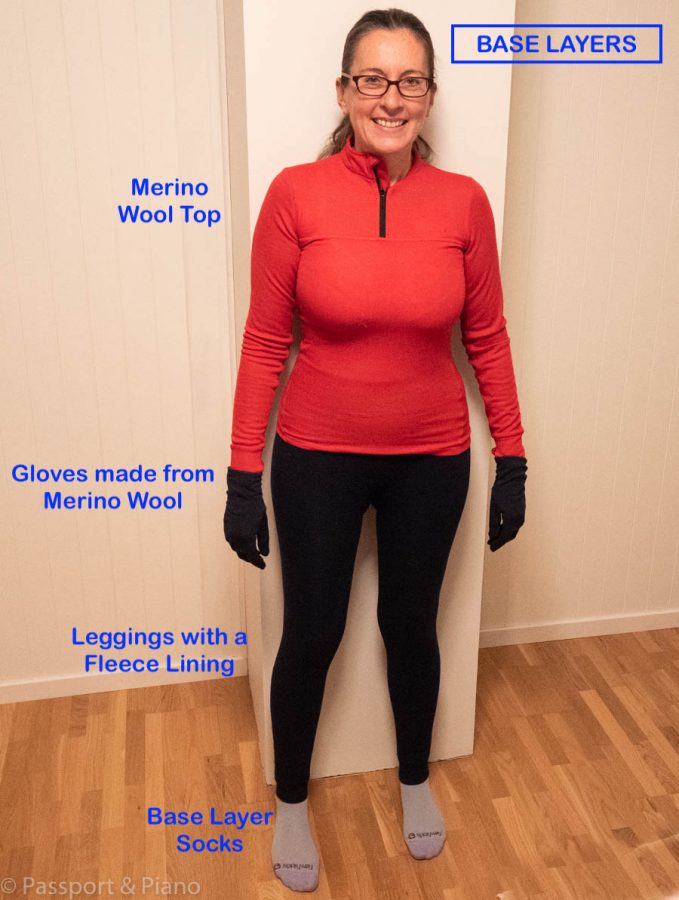
The most effective Norwegian base layers are made from Merino wool. The wool from merino sheep is lighter than most which make it less itchy and therefore suitable for most people, including those with sensitive skin.
There’s lots of variety in nordic clothing made from merino wool as its hugely versatile, and able to retain and diffuse heat when necessary.
Benefits of Merino Wool Winter Clothing
The best thing about merino wool is that it has natural antimicrobial properties. The wool deters the growth of bacteria which of course reduces the smell of body odour.
You can wear a merino wool garment for several days without it beginning to smell sweaty. Merino wool can hold a third of its weight in moisture before it starts to feel damp.
With the bulkiness of other winter clothing that you’ll need to pack its worth spending that little bit more and purchasing some merino wool base layers.
Another fantastic feature of merino wool is that it retains heat while still being breathable. In the same way that a down works on a duvet, the small fibres in merino wool pocket the air and keep the heat in for insulation.
The fibres are also breathable and act effectively. They can release heat when its no longer needed ensuring that you don’t overheat if you’re doing a more active Scandinavian winter sport.
Garments made from merino wool are lightweight and keep their shape unlike other fashionable winter clothing made from wool.
Merino wool has a large amount of stretch and will move with you during any activity, but it will also return to shape once you finish.
Merino woollen garments come in different weights so that you can choose the thickness of your base layer according to your Norway winter travel plans.
In cities and by the coast temperatures are warmer so a 200-weight layer would be sufficient.
However, if you’re travelling in the arctic wear 260-weight base layers or higher.
Best Outdoor Wear Brands for Base Layers
There are plenty of brands that make good thermal underwear, but if you’re looking for recommendations Minus 33 make fantastic affordable base layers.
However, if you don’t mind investing Smart Wool always come out on top in clothing reviews.
Cotton Clothing
It may be tempting to wear an outdoor vest made from cotton as your base layer, but that’s a no-no. Cotton is good at soaking up moisture, but it takes a long time to dry. Hence, it will make you feel cold.
Polyester Base Layers
Polyester is quick-drying and works well as a base layer if you are doing more vigorous activities. The downside of synthetic fabrics is that they soon begin to smell and need washing more frequently.
Silk Base Layers
Silk makes an excellent base layer for your hands, feet or head. You can wear it underneath more fitted clothes, but it’s not as effective as merino wool. However, it does feel lovely against your skin, and it can be an excellent option to wear under tighter fitting clothes.
What Base Layers to wear
You can buy base layers for virtually every part of your body. At the very least I would always wear a merino wool top and pair of leggings.
You can also add base layer gloves, socks, and hats.
Thermal Winter Clothing Fit
The base or thermal layer is the most critical layer to ensure that you get both the fit of garment correct and the appropriate fabric weight for the weather conditions.
Base layers for winter should not be too loose as you want the garment to trap the heat that your body creates. You also don’t want the thermal underwear to be too tight as this can be uncomfortable and restrict movement.
Functional base layers should fit snuggly – not too tight and not too loose.
Fabric Weight
Ultralightweight: Suitable for mild conditions
Lightweight: Good to wear for activities which will work up a sweat and in moderately cold weather
Midweight: Suitable for cold temperatures and sports activities
Heavyweight: The best option to wear beneath your northern lights clothing. Heavy fabrics are great to wear in snowy conditions and when temperatures are freezing.
Depending on how your body reacts to the cold will depend on which layer will suit you most. If you are used to living in a hot climate, you may need to go for a midweight or heavyweight fabric even if temperatures are over 0 degrees.
Mid-Layer Norway Clothing
The next layer of Norwegian clothing is called the mid-layer, which acts as insulation.
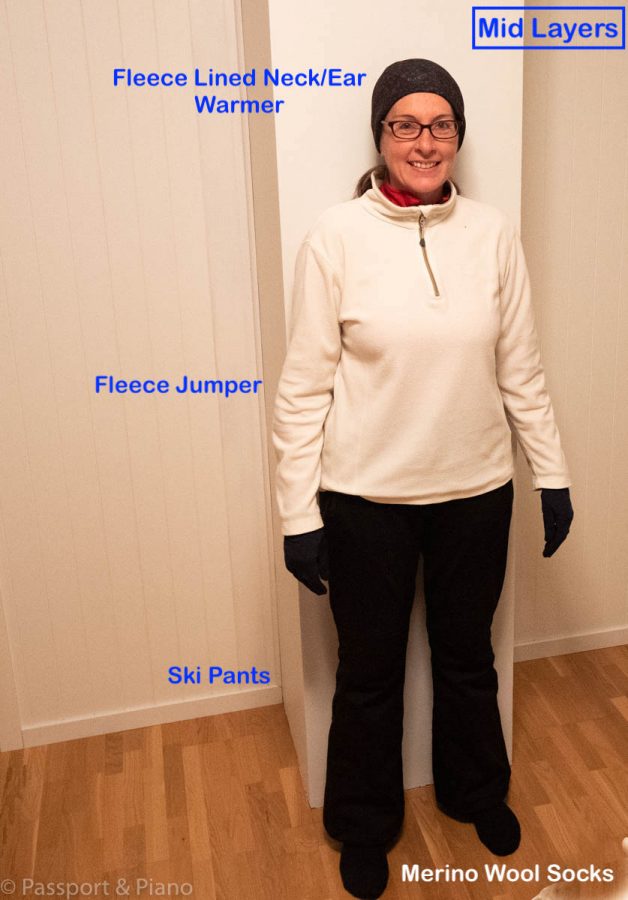
This layer can include lightweight polyester or Polypropylene tops, fleeces, Norwegian sweaters or woollen jumpers.
The best mid-layers are breathable, quick-drying and able to retain heat. As with the base layers, you are best avoiding cotton garments as they retain moisture and don’t dry quickly, which can make you feel cold.
Milder Temperatures
A thin fleece or a merino wool sweater is ideal for wearing on top of your base layers. Of course, you could put on a nordic sweater.
For bottoms, a comfy pair of trousers will be fine for sightseeing, but don’t forget to wear your base layers underneath. There’s no need to buy a special pair, but I’d recommend comfortable hiking trousers if you’re going to spend long days walking around cities.
Cold Weather
If temperatures go below zero its best to opt for a thicker fleece, thick jumper or softshell jacket as they provide more warmth. You could also opt for outdoor shirts and add a jumper over the top.
On the legs, I’d recommend ski pants with a pair of leggings underneath. It’s quite common in northern towns such as Tromso to wear skiwear in and around town.
Are you heading to Tromso? If so you may be interested in reading this Tromso guide to help plan your winter trip.
Extreme Weather Conditions
If you are going out for prolonged periods in the cold such as on a northern lights watch, then I would wear a couple of mid-layer garments. For example, a merino wool jumper and a fleece or insulated jacket.
I added a [easyazon_link identifier=”B00UR4DEPW” locale=”US” tag=”passportand0e-20″ cart=”n”]heated gilet[/easyazon_link] to my clothing as well as heated sole liners to my boots on my last aurora Borealis hunt. It can get bitterly cold in the middle of the night so layer up.
Some companies will provide you with thermal suits, so if your worried opt for a tour that includes them.
Note:-You wear the thermal suit over your outer layer clothing – NOT as a replacement.
To keep your legs warm, I’d suggest a thick pair of fleece-lined leggings and a good pair of snow pants.
Outer Layer Norway Clothing
For your Norwegian outerwear look for a jacket that’s breathable and both wind and waterproof. In most situations, a shell jacket is sufficient as your mid-layers do the job of keeping you warm. However, a Norwegian coat is an excellent alternative.
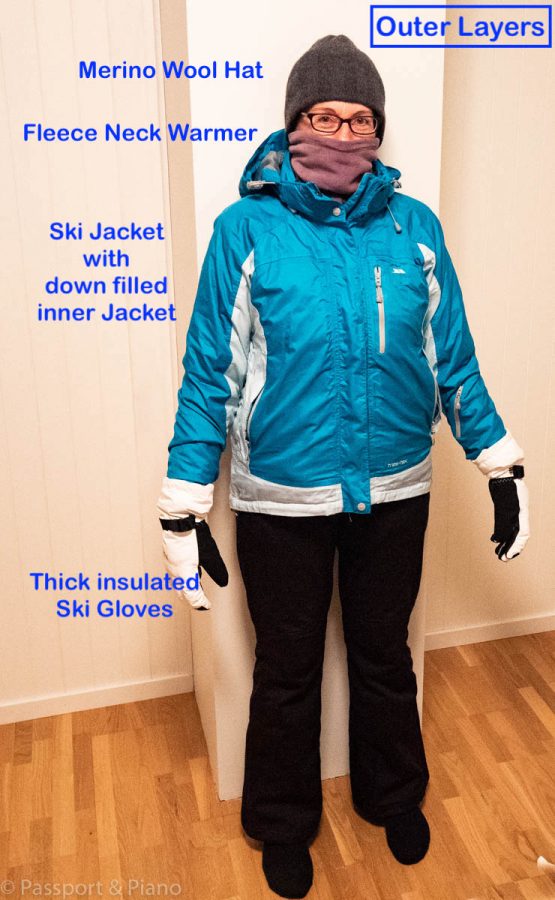
Gortex is a common choice for an outer layer Norwegian jacket. It’s a material that’s breathable and lightweight. Jackets made from Gortex are usually both wind and waterproof. They’ll also keep you dry in the snow.
Ski/hiking jacket or Norwegian Parka
Parkas were once the preferred choice of outdoor winter clothing. Still, with modern technologies, jackets are equally as effective at keeping you warm. Whichever you choose, go for a coat that is long enough to reach your thighs for added warmth.
Outer shell jacket
Norway winter jackets need to be water-resistant and windproof. If you’re spending prolonged periods in the snow, make sure you opt for a fully waterproof jacket, which will be more expensive but worth the investment.
Ski Jackets usually come with an inner fleece jacket for added warmth. The fleece is generally removable which gives the coat more versatility as you can remove the insulation layer if it’s not required.
Scandinavian Parka or Norwegian down jacket
The most important thing to consider when purchasing a parka style Norwegian coat or a Norway down jacket is the insulation material.
The more fill power the down has, the better as it will mean that the garment is lighter in weight and easier to compress if you need to pack it away.
Often nordic clothing brands use feathers from ducks or geese to fill high quality down jackets, which provide a fantastic and warm insulating layer. The feathers create lots of tiny air pockets which trap warm air and keep in the heat.
Goose down is the very best and lightest but is often more expensive than duck down. As with everything, there’s always a compromise.
Jackets filled with down are not great if they get wet as their ability to insulate is weakened plus they take a long time to dry out. They also require special cleaning, which can make them less practical if you’re participating in outdoor activities.
The modern method is to fill parkas with synthetic insulation which performs better in wet conditions and are often cheaper. However, they do tend to be heavier and don’t compress as effectively as feather down.
Additional things to look for in outdoor coats
The best-designed jackets and parkas give complete protection from the elements.
Drawcords around the neck and cuffs are beneficial. They can allow more ventilation if the weather is warm, but you can also tighten them to ensure the wind or snow doesn’t enter the neck and sleeves.
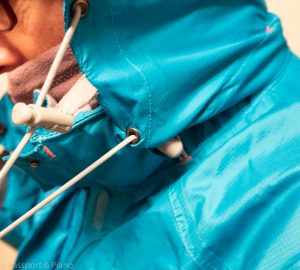
Having toggles on the zip pullers and hood string makes them easy to operated when wearing gloves.

Flaps over the zips prevent heat escaping and keep the wind, snow and rain out.
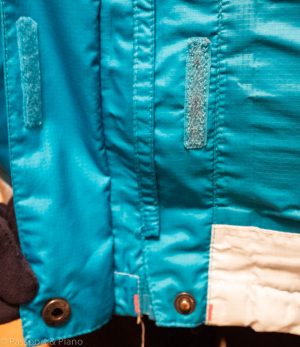
A hood is also useful as an extra layer if the weather suddenly turns and you need further protection against the elements.
Norwegian Outdoor Clothing Accessories
Your head, hands and feet also need protecting from the cold. As with the body layering garments is a fantastic way to keep warm.
Winter Hats
You can lose up to 50% of your body heat through your head, so wearing a hat will keep you warmer.
It’s also worth knowing that if your head gets cold, it can cause the blood vessels to tighten in other parts of your body. The effects of this mean that your hands or feet can feel cold even if you’re wearing thick socks and gloves.
Norwegian winter hats made from merino wool are the best to ensure that you conserve all your bodies heat. If your travelling inland or in the north of the country make sure your hat covers your ears.
For extra protection wearing a balaclava will give you added warmth and keep the wind away from your nose and cheeks.
Earmuffs
Your ears are more susceptible to the cold than you might think, and it’s advisable to protect them from prolonged periods of cold weather. The best way to keep your ears cosy is to wear earmuffs or a fleece-lined headband.
Winter Scarf
Wearing a scarf keeps a warm pocket of air around your neck, and you can use it to cover your mouth and nose as well. If your spending time in the city a fashion scarf will be sufficient but for colder temperatures opt for a thicker one.
Scarves made from cashmere or merino wool are an excellent option. You can also get neck gaiters which can give an added layer of insulation.
Winter Gloves
Depending on how cold it’s going to be on your visit, one pair of gloves may not be enough. Deciding which gloves to buy is always tricky as the warmest ones are not that practical if you want to take photographs or operate a mobile device.
For that reason, I still like to wear a base layer glove, either made from silk or merino wool. That way, when I take my ski gloves off my hands are still protected.
Mittens keep your hands warmer than gloves, but they can be a challenge to wear, and not everyone can manage with the restrictive movement that they cause.
Fingerless gloves are a good option for the cities when the temperature is not too cold. They offer some protection but also allow you to keep your fingertips free.
If you’re heading up to the arctic circle, opt for a base layer glove and a thick insulated pair on top. Ski gloves are a good option as they’re waterproof and windproof. They often have thick insulation as well.
Socks for Winter
Once again the layering system works well and wearing two pairs of thinner socks will keep your feet warmer than one thick pair. I always find that if my feet get cold, the rest of my body suffers.
Base layer socks made from a mix of wool and synthetic material fit snug to your feet. As a second pair, you can opt for a more everyday sock or a thicker woollen sock if you’re going to be in icy conditions.
I wear hand-knitted socks that I make myself from Rowan Fine-Art wool which is a mix of merino wool, mohair and silk. If you’re looking for a good pattern book, I highly recommend [easyazon_link identifier=”0956785182″ locale=”US” tag=”passportand0e-20″ cart=”n”]A Knitted Sock Society[/easyazon_link]
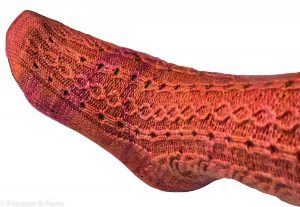
If knitting isn’t for you check these socks out, there’s plenty to choose from online.
Winter Boots
Ordinary boots are sufficient around the towns and cities. However, they’re not going to cut it in the snow or extreme temperatures. For trips in northern parts of Norway and adventures such as snowmobiling, you’re going to need a more substantial boot.
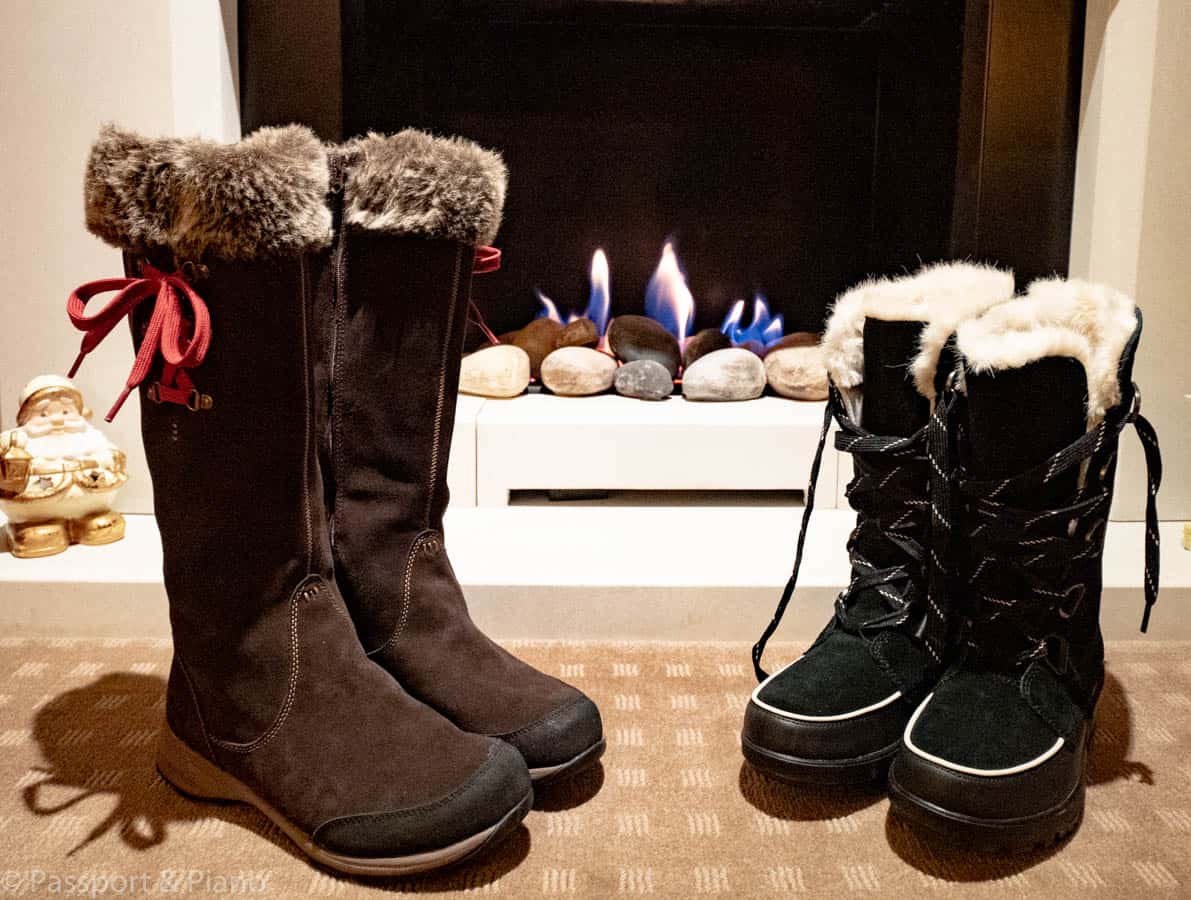
The sole needs to be thick and provide enough grip in the ice, you may also find that you need to add crampons if conditions are particularly treacherous. Snow boots by Sorrel and Kamik are an excellent choice.
- Cozy Boots for Women: Embrace cold and dry weather with these boots, so you can travel into the city or out in the country without worrying about cold feet
- High-Quality Materials: These high-quality women’s boots are crafted with premium materials, including waterproof suede for durability and protection
- Versatile Boots for Women: Embrace the versatility of these boots that are versatile enough to fit any outfit for any occasion
- Warm & Dry Boots: Stay warm and dry in the harshest weather conditions with these women’s boots, featuring 100g insulation for maximum warmth
- Superior Comfort: Experience ultimate comfort with these women’s boots, featuring a removable molded EVA insole for customizable cushioning
- Waterproof Shoes for Women: These winter snow boots for women are perfect for gearing up outside and walking around in snowy and slushy weather; these Caribou boots are waterproof
- Winter Boots for Women: These snow boots have a leather upper for durability and style; the waterproof work boots have a removable 9 mm washable recycled felt inner boot lining
- Women’s Boots from SOREL: This shoe for women has a rubber outsole for reliable traction; this snow boot has a 2.5 mm bonded felt frost plug midsole for warmth
- Caribou Women’s Boot from SOREL: This waterproof boot with laces allows you to adjust the tightness for a secure feel; the winter boot features a handcrafted, waterproof, and vulcanized rubber shell with a SOREL aero-trac non-loading outsole
- Shoes for Functionality & Fashion: SOREL combines craftsmanship and style to create all-season footwear that pushes the boundaries of function-first fashion
- Vegan-friendly
- Moisture wicking lining
- 95% Rubber, 5% Nylon
- Imported
- Man Made sole
- Built in USA
- Minus 40 Fahrenheit extreme temperature rating
- Waterproof RubberHe Bottom
- 8mm Thermal Guard removable liner (100% recycled content) and hook-and-loop strap
- 604 denier Nylon
Look for ones that have a flexible sole, a waterproof upper leather, a midsole that insulates against frost and sufficient grip on the outer sole. They should also have an insulating layer for added warmth and protection.
I love my Sorel snow boots, and while they weren’t cheap, they were indeed worth the investment.
Crampons
Crampons are worth adding to your Norwegian snow boots if you’re visiting in winter. While the roads are often cleared of snow, the pavements aren’t and it quickly turns to ice in the cold climate.
Even if you are only going to walk around town, if there’s snow on the ground that’s frozen, wearing crampons is advisable. You don’t want to fall and end up waiting for an x-ray.
Make sure you are covered with travel/medical insurance before you travel.
Heated Winter Clothing
I feel the cold more than most and although the layering system certainly does work by adding heated clothes, you can add extra warmth as and when you need.
Heated clothes have unique panels inside them which have elements that flex and bend so your movements aren’t restricted. A portable USB power bank that fits in the pocket enables the components to work.
Most garments have three settings so that you can adjust the temperature. I adore my heated Gilets; you can wear them in all conditions as they’re temperature controlled.
When I visited Tromso in the north of Norway in December, I wore the heated gilet on its maximum setting as part of my arctic clothing.
I used the [easyazon_link identifier=”B00UR4DEPW” locale=”US” tag=”passportand0e-20″ cart=”n”]heated gilet[/easyazon_link] on its lowest setting as part of my Oslo Norway winter gear, which worked great as I could simply turn the heat off when indoors.
You can also get [easyazon_link identifier=”B07CZYQFZN” locale=”US” tag=”passportand0e-20″ cart=”n”]heated socks[/easyazon_link], gloves and headgear which are all worth investing in if you’re looking to add to your arctic gear.
Extras to put on your Norway Winter Packing List
While wearing the right Norway winter clothing will keep you warm, these extra things go one step further and are worth adding to your Norway wear.
Hand warmers
In addition to wearing gloves, hand warmers give that extra heat which is useful if your out in the cold all day or aurora watching at night. Disposable ones, such as [easyazon_link identifier=”B00PGBN11S” locale=”US” tag=”passportand0e-20″ cart=”n”]hot hands[/easyazon_link] are cheaper than reusable ones.
They’re made from environmentally friendly material and give heat for approximately 8 hours. The air activates them once you open the packet and provide them with a shake.
If you prefer a reusable option check out these hand warmers, they’re more expensive, but they tend to give off slightly more heat than the disposable ones.
Heated Sole Liners
In a similar way that you can purchase hand warmers to put inside your gloves, you can also get heated sole liners to fit on the base of your foot.
Whether you get environmentally disposable ones or rechargeable ones, they are fantastic and provide extra warmth to your boots. Norway temperatures, especially in the north and inland can be bitter in winter, and there’s nothing worse than your feet getting cold.
[easyazon_link identifier=”B001UQXAT6″ locale=”US” tag=”passportand0e-20″ cart=”n”]Heated sole liners[/easyazon_link] give around 8 hours additional heat, and I highly recommend for activities such as northern lights hunting.What Norwegian outfit to wear when flying
Unless you live in the northern hemisphere, you’re likely to be travelling from a warmer climate when you visit Norway. However, you’ll regret not considering the temperature at your destination.
In Tromso, we exited the plane onto to an airbridge but unlike most airports, the bridge didn’t take us straight inside. We had to then climb down some stairs and walk across the tarmac to the terminal.
I wore a thermal top base layer with ski pants and my snow boots. I also put a thick fleece in my hand luggage along with my ski gloves, hat and scarf.
For practical reasons I wore my winter parka as it was too big to fit in the suitcase. I did end up carrying around the airport, but at least I could put it in the overhead lockers on the plane.
When we stepped outside I was grateful that I had it on as the snow and ice was bitterly cold.
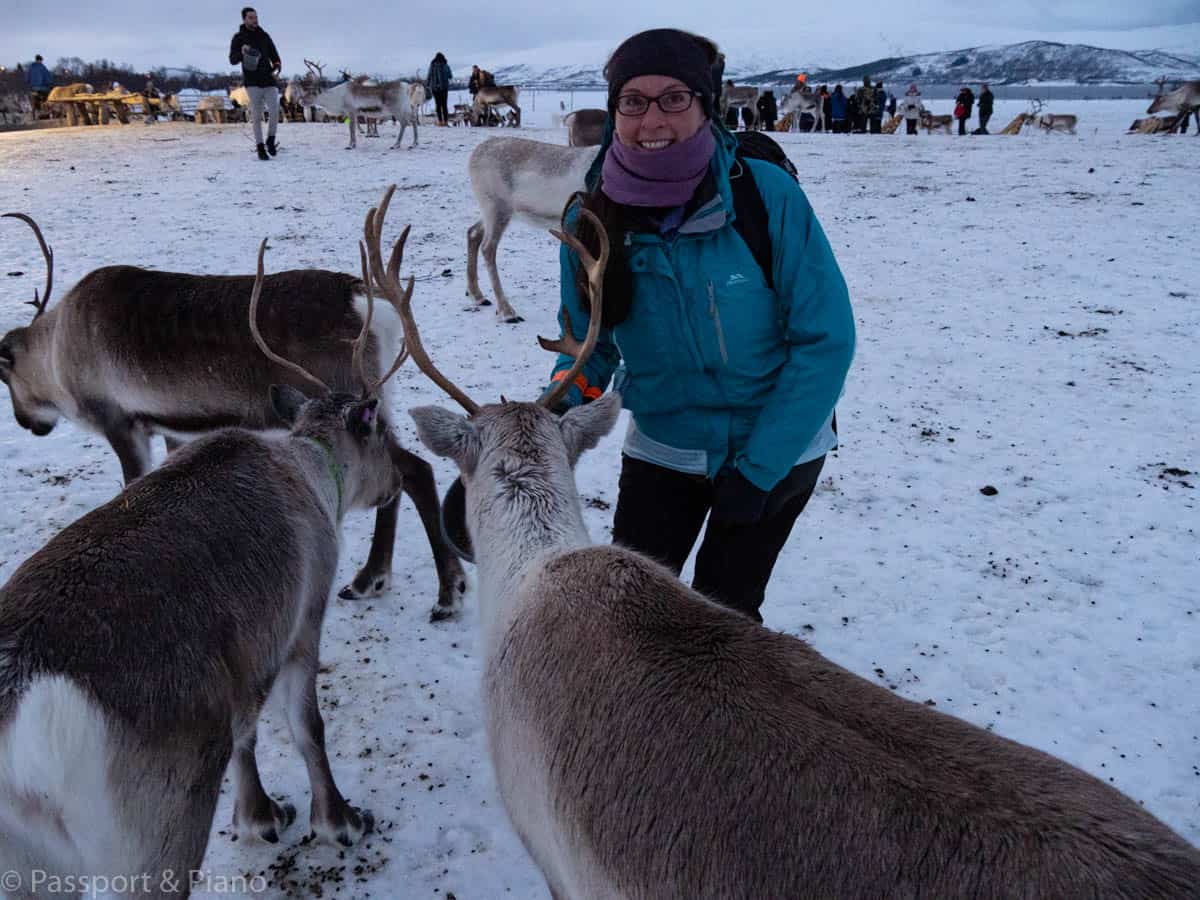
Passport and Piano is a participant in the Amazon Services LLC Associates Program, an affiliate advertising program designed to provide a means for sites to earn advertising fees by advertising and linking to amazon.com, amazon.co.uk, amazon.ca. Amazon and the Amazon logo are trademarks of Amazon.com, Inc. or its affiliates.























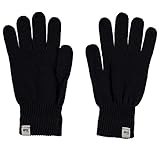






Thank you for the visual aid in your guide to Norwegian attire. What would you recommend for waterproof trousers? Water repellent trousers aren’t effective in long rainfall exposure and i have not found any waterproof overtrousers that aren’t excessively baggy.
Weather in Bergen and Aalesund vigra show to be quite cool and wet in June would like to be suitably dressed to enjoy time the trip, however as i’ll be spring boarding from a hotter destination of shorts and linen shirts i’d like to be efficient with packing and not let the current summer sun blindside me to the reality of a colder temperature that can come with rain.
P.S. Think you have such an interesting job that it takes you to far flung places!
Author
I carry a pair of waterproof trousers that you can slip on if need be. The weather won’t be that cold in June, and it’s unlikely to rain all day every day. Have a wonderful trip, it’s a beautiful part of the world.
Hi
Thanks for found article on what to wear in Norway in winter – it’s really helpful. Just to clarify do you recommend wearing (on the bottom half) 1. A thermal base layer bottoms, as well as 2. Normal leggings, then 3. ski pants as well as carrying 4. waterproof trs in your bag? Thanks so much! I’ve never been anywhere cold so don’t have a clue